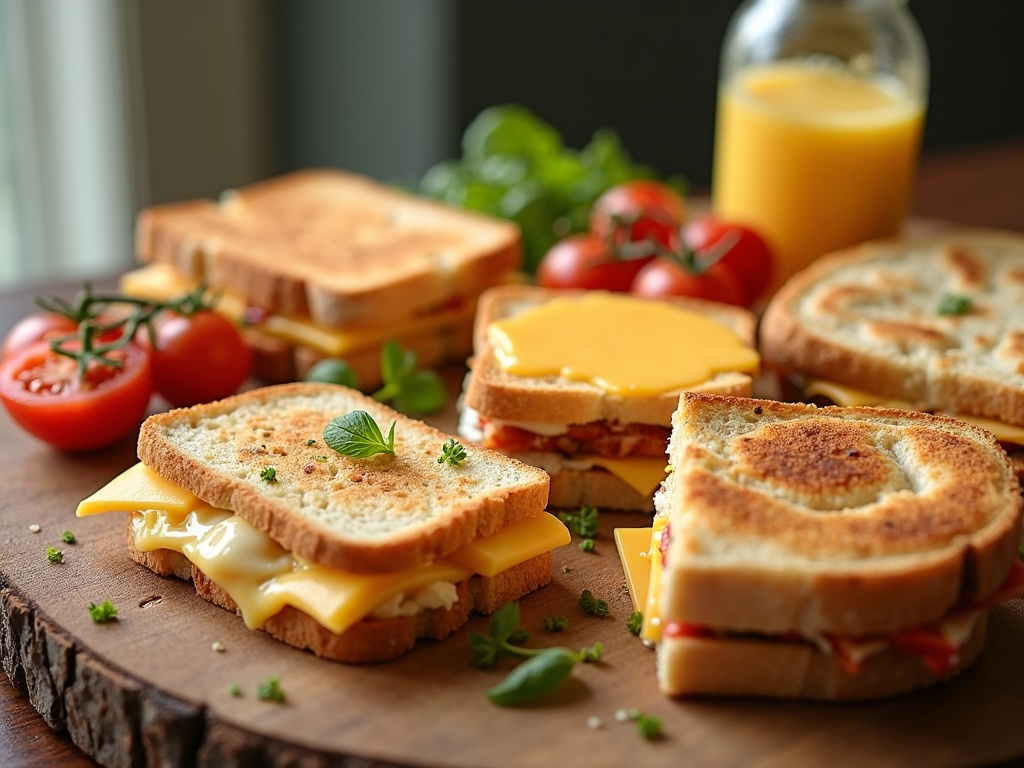The humble cheese sandwich represents a universal comfort food that transcends cultural boundaries and generations, offering both simplicity and satisfaction in equal measure. From America’s Depression-era grilled cheese to France’s sophisticated croque monsieur, this unpretentious creation has evolved into countless regional variations while maintaining its core appeal of melted cheese between bread.
Find In This Article
Key Takeaways
- The perfect cheese sandwich depends on quality ingredients – selecting the right bread variety and cheese type creates the foundation for success.
- Proper assembly techniques matter – toasting bread lightly prevents sogginess while applying spreads edge-to-edge ensures consistent flavor in every bite.
- Common mistakes include using incorrect bread thickness, poor cheese selection, and improper heating temperature that leads to burned bread and unmelted cheese.
- Creative variations include vegetarian options with avocado or roasted vegetables, meat additions like turkey or pastrami, and international inspirations from Mediterranean to Mexican cuisines.
- Cheese sandwiches offer good nutritional value, especially when made with whole grain bread, and can be adapted for various dietary needs including gluten-free and dairy-free requirements.
Why Everyone Needs This Classic Comfort Food
The humble cheese sandwich holds a special place in culinary traditions worldwide. I’ve found that few foods can match its perfect combination of simplicity and satisfaction. This unpretentious creation bridges cultural divides and generations, serving as both a childhood memory and an adult comfort.
Cultural Significance and Global Variations
Cheese sandwiches represent more than just a quick meal—they’re cultural touchstones. In America, the grilled cheese sandwich emerged during the Great Depression as an affordable, protein-rich option. Today, it remains a nostalgic favorite at diners across the country.
Around the world, different cultures have embraced cheese sandwiches in fascinating ways:
- France celebrates the croque monsieur, a sophisticated grilled ham and cheese sandwich topped with béchamel sauce.
- Italy offers the panini, pressed sandwiches featuring mozzarella or provolone with Mediterranean ingredients.
- India created the Mumbai sandwich, layering cheese with spiced potatoes, cucumbers, and chutney between buttered bread.
- Mexico’s quesadilla transforms the concept using tortillas instead of bread.
Each variation reflects local ingredients and cultural preferences while maintaining the core appeal of melted cheese and bread. While some might enjoy an egg sandwich with cheese for breakfast, others prefer simpler options like a toast sandwich with cheese melted on top.
The cheese sandwich also stands as one of life’s most practical meal solutions. I’ve relied on it countless times when pressed for time or when the pantry looks sparse. With just bread, cheese, and perhaps butter, I can create a satisfying meal in minutes. Add a few extras like tomatoes, herbs, or mustard, and it transforms into something special without significant effort.
For busy parents, cheese sandwiches offer a reliable solution for picky eaters. For college students, they provide affordable nourishment between classes. For late-night workers, they deliver comfort after a long day. This universal appeal explains why the cheese sandwich has endured through changing food trends and dietary shifts.
Beyond convenience, cheese sandwiches deliver comfort in a way few foods can match. The combination of carbohydrates from bread and protein from cheese creates a satisfying meal that feels like home, regardless of where you’re from or what variation you prefer.

Essential Ingredients for the Perfect Cheese Sandwich
Creating the perfect cheese sandwich is an art form that relies on quality ingredients working in harmony. I’ve found that selecting the right components can transform a simple snack into a memorable meal. Let’s explore the key ingredients that will elevate your cheese sandwich experience.
Bread: The Foundation of Greatness
The bread you choose serves as both the canvas and the frame for your cheese sandwich masterpiece. Each variety brings its own character to the final creation:
- Sourdough: Offers a tangy flavor and chewy texture that stands up well to melted cheese. The slight acidity cuts through rich cheese beautifully.
- Whole Grain: Adds nutty notes and extra fiber for a more nutritious option. The hearty texture provides substantial bite.
- Classic White: Provides that nostalgic, soft texture many love. Its mild flavor lets the cheese shine as the star.
- Rye: Brings a distinctive flavor that pairs exceptionally well with sharp cheeses like cheddar or Swiss.
- Ciabatta: Creates a crusty exterior with airy pockets perfect for capturing melted cheese.
I’ve discovered that toasting the bread lightly before adding cheese helps prevent sogginess and adds delightful texture contrast. For an interesting alternative to traditional bread options, you might consider trying a toast sandwich variation that plays with textures in a unique way.
Selecting Cheese
When selecting cheese, consider both flavor profile and melting properties:
- Cheddar: The classic choice offering reliable melting and that familiar sharp bite
- Swiss: Features distinctive holes and a nutty sweetness that melts beautifully
- Gruyère: Delivers complex flavor with excellent meltability for an upscale sandwich
- Mozzarella: Provides that stretchy, photo-worthy cheese pull
- Blue cheese: Adds bold, tangy pockets of flavor (use sparingly and pair with milder cheeses)
- Provolone: Offers smooth melting with a mild flavor that complements most ingredients
- Brie: Creates a creamy, indulgent sandwich with its soft texture and buttery taste
For the ultimate cheese experience, I recommend combining two or three cheese varieties. A sharp cheddar paired with creamy mozzarella, for instance, gives you both flavor depth and that perfect melty texture.
Spreads and Add-Ins
The spreads and add-ins you choose can take your sandwich from good to extraordinary:
- Butter: The traditional choice that enhances browning and adds richness
- Mayonnaise: Creates an exceptionally crispy exterior when used for grilling
- Mustard: Dijon or whole grain adds tanginess that cuts through rich cheese
- Chutney or jam: Fruit spreads provide a sweet contrast to savory cheese
- Herbs: Fresh basil, thyme, or rosemary infuse aromatic complexity
- Thinly sliced apple or pear: Add sweetness and crunch
- Caramelized onions: Contribute sweet depth and silky texture
- Pickles: Provide acid and crunch to balance rich cheese
I’ve found that an egg sandwich recipe approach can inspire interesting additions like a fried egg on top of your cheese sandwich for added protein and luxurious texture.
The perfect cheese sandwich comes down to balancing flavors and textures while using quality ingredients. Start with these essentials as your foundation, then customize to create your own signature version that satisfies your specific cravings.
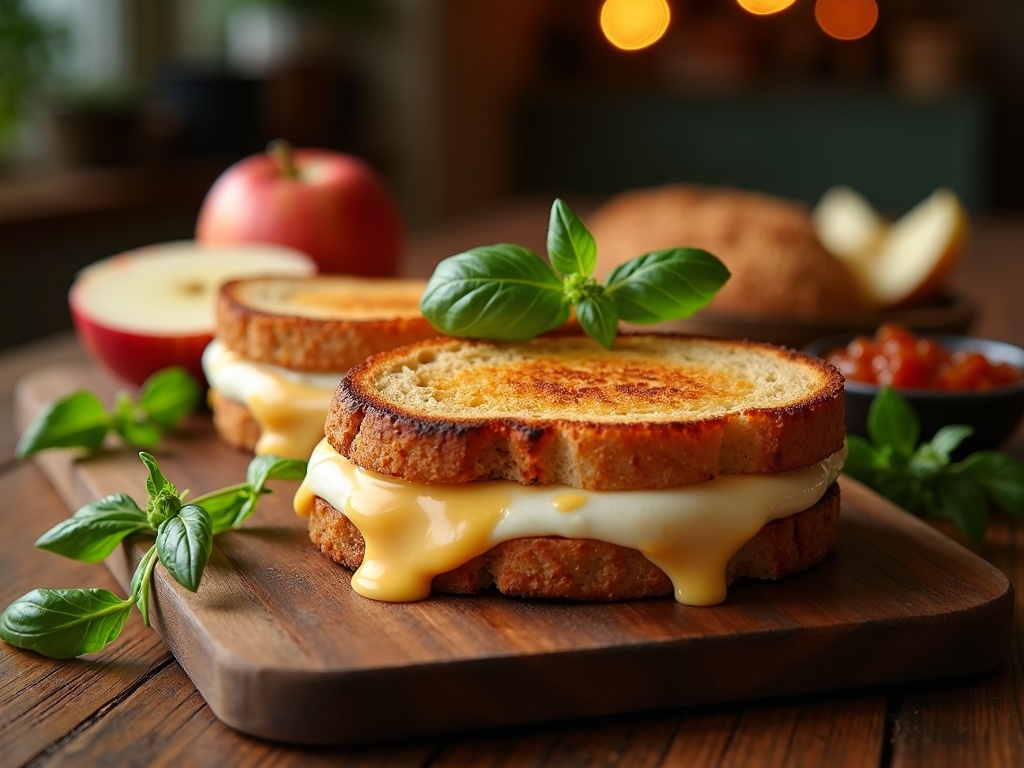
Step-by-Step Sandwich Assembly
The perfect cheese sandwich is more than just slapping cheese between bread. I’ve found that following a proper assembly sequence creates flavor layers that transform this simple meal into something truly delightful.
Preparing the Bread
First, I select quality bread as the foundation. Sourdough, whole wheat, or classic white all work wonderfully depending on preference. I always toast the bread lightly to add texture and prevent sogginess when adding moist ingredients. Toasting also brings out the natural flavors in the bread, creating a more complex taste profile. For variety, you might consider trying a toast sandwich approach with different levels of toasting for added texture.
When working with thicker breads, I sometimes hollow out a small portion of the center. This creates a pocket that holds fillings securely and provides better bite distribution.
Adding Spreads and Condiments
Spreads serve dual purposes – adding flavor and creating moisture barriers. I apply them in this order:
- Butter or mayonnaise directly on both bread slices (prevents sogginess)
- Mustard, hummus, or pesto as secondary layers
- Specialty spreads like olive tapenade or roasted garlic aioli for gourmet versions
The key is applying spreads edge-to-edge for consistent flavor in every bite. I’m careful with portions – too much creates mess, too little leaves the sandwich dry.
For moisture management, I place drier spreads against the bread and reserve wetter ingredients for the middle layers. This technique keeps the structural integrity intact while maximizing flavor.
When constructing a classic egg sandwich with cheese, I apply the condiments differently – placing them between the egg and cheese layers for better flavor distribution.
Layering Cheese and Extras
Cheese placement is crucial for proper melting. I place harder cheeses (cheddar, provolone) directly against a spread layer, while softer varieties (brie, cream cheese) work better in the middle.
For maximum flavor development, I follow this layering sequence:
- Bottom bread with spread
- Leafy ingredients (lettuce, spinach)
- Cheese slice(s)
- Additional fillings (tomatoes, onions, avocado)
- Second cheese layer (optional)
- Top bread with spread
This arrangement allows the cheese to properly melt and adhere to other ingredients, creating that perfect cheesy pull when taking a bite.
Remember that thin-sliced cheese melts more evenly than thick chunks. When using multiple cheese varieties, I place the mildest closest to the bread and strongest in the center for balanced flavor development.
I’ve discovered the best cheese sandwiches allow each ingredient to shine while contributing to a harmonious whole.
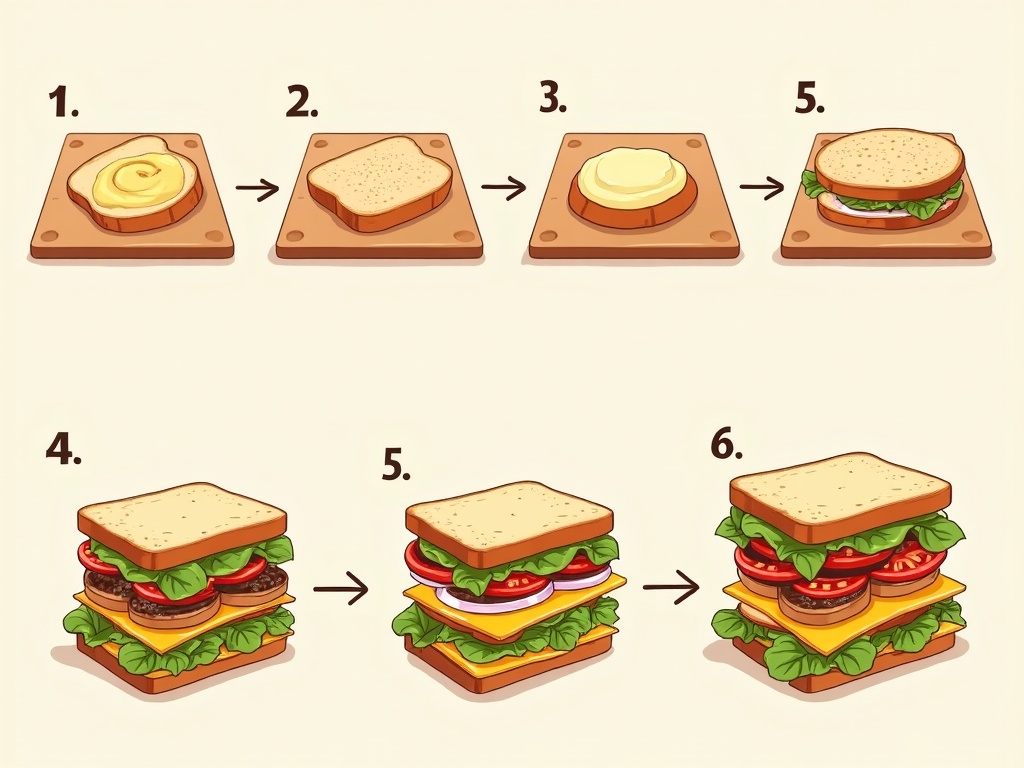
Common Mistakes That Ruin Your Sandwich
I’ve tasted my fair share of cheese sandwiches—both magnificent and miserable. The difference often comes down to avoiding some surprisingly common pitfalls that can transform your potential masterpiece into a disappointing mess.
Bread and Cheese Blunders
Using the wrong bread thickness ranks high on my list of sandwich sins. Bread that’s too thick overwhelms the cheese flavor, while overly thin slices can’t support the filling and turn soggy. For a balanced cheese sandwich, I recommend medium-cut bread (about ½ inch thick) that provides structure without dominating.
Poor cheese selection can instantly doom your sandwich. Many home cooks grab whatever cheese is in the fridge without considering meltability or flavor intensity. Cheeses like American and Gruyère melt beautifully, while harder varieties like aged cheddar need to be thinly sliced or grated. For even better results, try combining a melty cheese with a flavorful one—this technique works especially well in egg sandwiches with cheese where the proteins complement each other.
Temperature and Storage Issues
Incorrect heating temperature is a frequent mistake that leads to burned bread and unmelted cheese. I’ve found the secret is medium-low heat that allows the bread to toast gradually while giving the cheese time to melt completely. Rushing this process with high heat creates that dreaded combination of charred exterior and cold center.
Improper storage of ingredients affects your sandwich quality before you even start cooking. Cheese stored incorrectly (too warm or unwrapped) dries out or absorbs refrigerator odors. Fresh bread left in plastic packaging gets soggy, while bread stored improperly becomes stale. I keep my cheese wrapped in parchment paper then placed in a loose plastic bag, and store bread at room temperature in a bread box or paper bag for up to three days.
These fundamentals apply to various sandwich styles, from basic grilled cheese to more complex creations. Even a simple toast sandwich requires attention to these details for the best results.
By avoiding these common errors, your cheese sandwiches will consistently deliver that perfect combination of crispy exterior, melty interior, and balanced flavors that make this simple food so satisfying.
Pro Tips for Cheese Sandwich Success
The perfect cheese sandwich isn’t just about slapping cheese between bread—it’s an art form that rewards attention to detail. I’ve discovered that mastering a few key elements can transform this simple meal into something extraordinary.
Perfecting Your Foundation
Getting the cheese-to-bread ratio right is crucial for sandwich harmony. I find that for a standard sandwich, about 1.5 to 2 ounces of cheese per sandwich strikes the ideal balance. Too little cheese leaves you wanting more flavor, while too much can overwhelm the bread and create a greasy mess. The thickness of your bread matters too—hearty, thicker slices can support more cheese, while thinner bread works better with a lighter cheese application.
To achieve perfect melting, temperature control is everything. I start with room temperature cheese, which melts more evenly than cold cheese straight from the fridge. When cooking, use medium-low heat rather than high heat, which allows the cheese to melt thoroughly before the bread burns. Covering your pan with a lid for about 30 seconds creates steam that helps melt the cheese completely.
For extra melty goodness, try these cheese combinations:
- Mild cheddar with monterey jack for smooth texture
- Gruyère and fontina for rich, nutty flavor
- Mozzarella with provolone for that perfect cheese pull
- American cheese mixed with sharper varieties for creaminess and flavor
If you’re looking for more sandwich inspiration, check out this delicious egg and cheese sandwich recipe that combines protein with melty goodness.
Creative Flavor Combinations
Taking your cheese sandwich to the next level means thinking beyond just cheese. I’ve experimented with countless additions that complement cheese beautifully:
Adding thin apple slices to sharp cheddar creates a sweet-savory contrast that’s irresistible. Caramelized onions paired with gruyère bring depth and sweetness. For a Mediterranean twist, try feta with roasted red peppers and a touch of olive oil.
Don’t forget that a classic toast sandwich can be elevated with the right cheese and proper technique.
For storage, I wrap uneaten sandwiches in parchment paper rather than plastic wrap, which preserves the texture better. When reheating, avoid the microwave which can make bread soggy. Instead, use a pan on low heat with a cover, or a toaster oven at 300°F for about 5 minutes to restore crispness while remelting the cheese.

Make It Your Own
The beauty of a cheese sandwich lies in its endless potential for customization. I can transform this simple comfort food into something extraordinary with just a few tweaks.
Creative Variations for Every Taste
Vegetarian options take this classic to new heights. I like adding sliced avocado for creaminess, roasted red peppers for sweetness, or grilled eggplant for a meaty texture. Caramelized onions mixed with mushrooms create an umami explosion that pairs perfectly with sharp cheddar. For a protein boost, I sometimes add hummus or falafel crumbles.
Meat enthusiasts aren’t left out of the cheese sandwich revolution. Turkey or chicken breast slices complement milder cheeses like havarti or swiss. Beef pastrami pairs wonderfully with provolone, while halal pepperoni and mozzarella create a pizza-inspired delight. For breakfast versions, I find that halal beef bacon and a fried egg turn a simple cheese and egg sandwich into a morning masterpiece.
Drawing inspiration from global cuisines opens up exciting possibilities:
- Mediterranean: Feta cheese with olives, cucumber, and tzatziki
- Mexican: Pepper jack with guacamole, corn, and black beans
- French: Brie with apple slices and honey
- Indian: Paneer with chutney, cucumber, and curry spices
Adapting to seasonal ingredients keeps my cheese sandwiches fresh year-round. Spring calls for fresh herbs and tender greens, while summer brings juicy tomatoes and basil. Fall inspires me to include apple slices with cheddar, and winter is perfect for heartier combinations like toasted bread with gruyère and caramelized onions.
The cooking method can transform the experience too. Grilling creates those irresistible crispy edges, while pressing makes for a compact sandwich perfect for picnics. Some days I prefer it cold with crusty bread, while other times I crave it warm and melty.
Remember that quality ingredients make all the difference. Freshly baked bread, artisanal cheeses, and seasonal produce elevate even the simplest combinations. Don’t forget about spreads either—garlic aioli, pesto, or even fruit preserves can add unexpected dimensions to your creation.
Next time you’re staring at that block of cheese in your refrigerator, think beyond the basics. With these ideas as your starting point, you’ll never eat the same cheese sandwich twice.
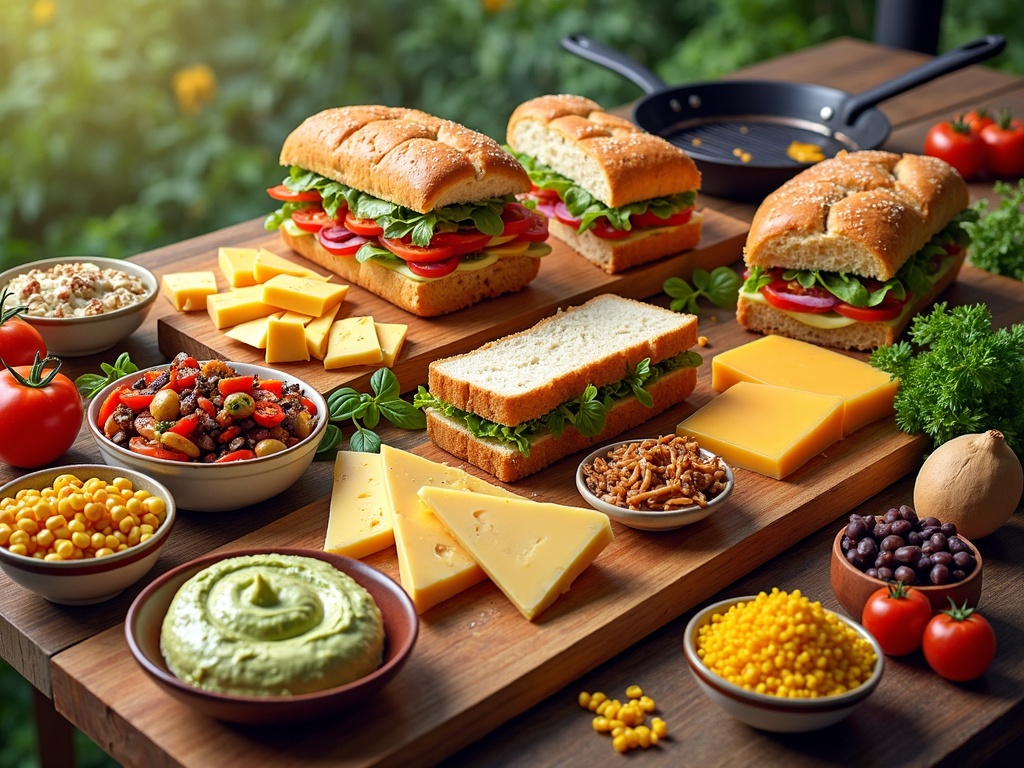
Health and Nutrition Notes
A cheese sandwich might seem like a simple meal choice, but it packs a surprising nutritional punch when prepared thoughtfully. I’ve found that understanding the nutritional profile of this classic can help you enjoy it while maintaining a balanced diet.
Nutritional Breakdown
The calorie content of a cheese sandwich varies significantly depending on ingredients. A basic sandwich made with two slices of white bread and one slice of cheddar cheese typically contains around 300-350 calories. When using whole grain bread instead, you’ll get additional fiber while maintaining a similar calorie count. Adding extras like butter or mayonnaise can quickly increase the calorie content by 50-100 calories per tablespoon.
Cheese sandwiches offer good protein content, which is essential for muscle maintenance and overall health. A standard sandwich with one slice of cheddar cheese provides approximately 10-15 grams of protein. This represents about 20-30% of the daily protein requirement for an average adult. I’ve discovered that using higher-protein cheese varieties like Swiss or adding a second slice can boost this further, though it comes with additional calories and fat.
For those monitoring fat intake, consider these alternatives:
- Low-fat cheese options (reduced-fat cheddar, part-skim mozzarella)
- Plant-based cheese substitutes for those avoiding dairy
- Cottage cheese as a spreadable alternative with higher protein content
- Nutritional yeast for a dairy-free option with a cheesy flavor
Dietary Modifications
For those with specific dietary needs, a cheese sandwich can be adapted in numerous ways. Gluten-free bread options have improved dramatically in taste and texture in recent years, making them viable alternatives for those with celiac disease or gluten sensitivity.
Dairy-free options have also expanded beyond traditional offerings. Modern plant-based cheeses made from nuts, soy, or vegetable oils can provide similar mouthfeel and melting properties to dairy cheese. I’ve tried several varieties and found that while they don’t perfectly replicate the taste of traditional cheese, many offer satisfying alternatives with lower saturated fat content.
Portion control is key when incorporating cheese sandwiches into a balanced diet. Instead of making a full sandwich with two slices of bread, consider these strategies:
- Prepare open-faced sandwiches using one slice of bread
- Cut a regular sandwich into quarters and pair with a vegetable-based soup or salad
- Use smaller bread slices or thin-sliced bread varieties
- Control cheese portions by using a cheese slicer for thin, consistent slices
Adding vegetables to your toast sandwich not only enhances nutritional value but also increases volume and satisfaction. Sliced tomatoes, cucumber, lettuce, or roasted red peppers add minimal calories while providing vitamins, minerals, and fiber.
For a more substantial meal with balanced nutrition, consider turning your basic egg sandwich recipe into a protein-packed option by adding an egg. This addition provides high-quality protein along with essential vitamins and minerals.
The bread choice substantially impacts the nutritional profile of your sandwich. Whole grain varieties offer more fiber, B vitamins, and minerals than refined white bread. Sourdough bread provides potential digestive benefits due to its fermentation process, while seed-containing bread adds healthy fats and additional protein.
When choosing cheese, consider that harder, aged varieties like Parmesan and sharp cheddar often deliver more flavor in smaller amounts, allowing you to use less while maintaining satisfaction. This approach reduces overall calorie and fat content while still providing the cheese experience you crave.
By making thoughtful choices about ingredients and portions, a cheese sandwich can be part of a nutritious eating pattern that supports your health goals while satisfying your taste preferences.
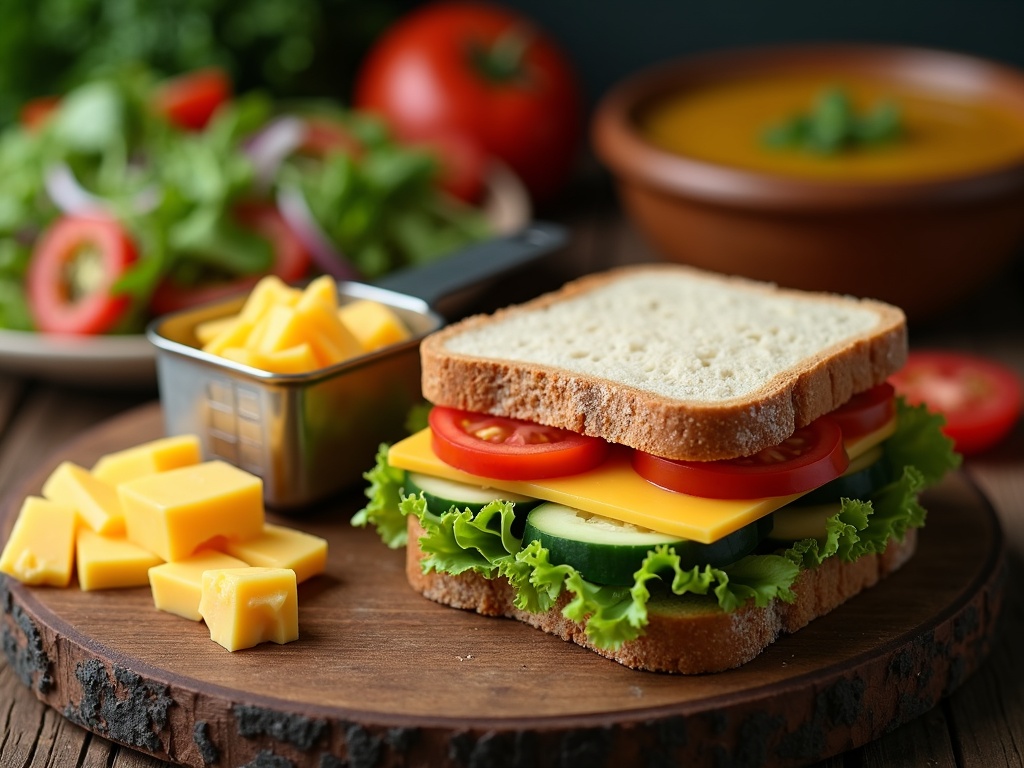
Serving Suggestions
Serving a cheese sandwich might seem straightforward, but with the right accompaniments and presentation, it can be elevated from a simple lunch to an impressive meal. I’ve found that paying attention to the details makes all the difference when serving this versatile dish.
Perfect Pairings and Presentation
A cheese sandwich pairs beautifully with a variety of side dishes that complement its rich, savory flavors. Some of my favorite accompaniments include:
- Crisp pickle spears or gherkins that cut through the richness
- Fresh green salad with a light vinaigrette
- Homemade coleslaw for a creamy, crunchy contrast
- Sweet potato fries for a more substantial meal
- Tomato soup for the classic comfort food combination
For presentation, I like to keep things simple yet appealing. Cutting sandwiches diagonally creates triangles that show off the layers inside and makes them easier to handle. For a more elegant touch, I remove the crusts and cut them into finger sandwiches. A sprinkle of fresh herbs like chives or parsley adds color and freshness to the plate.
Serving on wooden boards gives a rustic, café-style feel, while individual plates with colorful garnishes work well for more formal settings. Don’t forget a small ramekin of extra condiments like mustard or chutney on the side, allowing guests to add more flavor if desired.
For a complete meal presentation, consider adding an egg sandwich on the side for protein variety, creating a sandwich sampler that offers different flavors and textures.
Entertainment Serving Tips
When serving cheese sandwiches at parties or gatherings, I’ve discovered several approaches that work particularly well:
Make a sandwich bar where guests can build their own creations. Set out different breads, cheese varieties, spreads, and toppings so everyone can customize to their taste. This interactive approach is always a hit and accommodates different preferences.
For larger gatherings, prepare mini versions of cheese sandwiches. Quarter-sized sandwiches are perfect finger food that guests can enjoy while mingling. Consider making a variety of cheese combinations to cater to different tastes.
An toast sandwich station alongside your cheese sandwich offerings provides great textural contrast and gives guests more options.
For beverages, the right drink can enhance the cheese sandwich experience significantly. Light, crisp beverages generally work best to balance the richness of cheese. Some excellent options include:
- Sparkling water with lemon or cucumber for a refreshing non-alcoholic option
- Iced tea, particularly black tea or herbal varieties
- Apple juice or apple cider for a sweet complement
- Coffee or hot chocolate for breakfast or brunch service
- Mint lemonade for a cooling effect, especially with spicier cheese combinations
For adult gatherings, consider serving light beers, apple cider, or white wines like Sauvignon Blanc or Pinot Grigio. These beverages have enough acidity to cut through the richness of the cheese without overwhelming the flavors.
Temperature considerations are also important when serving cheese sandwiches. They’re best enjoyed fresh, but if preparing ahead for a party, I wrap them tightly and keep them refrigerated until about 15-20 minutes before serving. This timing allows the cheese to soften slightly while keeping everything food-safe.
For outdoor events, keep sandwiches in coolers until needed, and consider serving them on platters nested in ice if the weather is particularly warm.
When to Serve
I’ve found that cheese sandwiches are incredibly versatile meal options that fit almost any occasion. Their simplicity makes them perfect for busy days, while their customization potential elevates them to party-worthy status. Let me share some ideal times to serve these delicious creations.
Quick Lunch Ideas
Cheese sandwiches are my go-to solution when time is limited but hunger is real. They take just minutes to prepare but deliver satisfying results. On busy workdays, I prepare a basic grilled cheese with sharp cheddar and a slice of tomato for added freshness. For something more substantial, adding turkey or chicken transforms it into a complete meal.
For meal prep enthusiasts, cheese sandwiches can be partially prepared ahead of time. I often slice cheese and prep ingredients in advance, storing them in separate containers. This approach cuts down assembly time when I’m rushing between meetings.
These sandwiches pair wonderfully with simple sides:
- A handful of carrot sticks or cucumber slices
- A small cup of tomato soup for dipping
- A mixed green salad with light vinaigrette
- Fresh fruit for a sweet contrast
For a different lunch experience, try preparing an egg and cheese sandwich with a fried egg and melted cheese for protein-packed midday fuel.
Cheese sandwiches also make excellent packed lunches. I wrap them in parchment paper rather than plastic wrap to prevent sogginess, especially for grilled varieties that need to maintain their crisp exterior.
During picnics or outdoor activities, cheese sandwiches hold up well and don’t require reheating. I find that harder cheeses like cheddar, provolone, or Swiss work best for these occasions as they travel better than soft varieties.
For quick office lunches, I sometimes prepare cheese sandwich components separately and assemble them just before eating. This prevents the bread from getting soggy and maintains the perfect texture.
When hosting informal gatherings where timing matters, cheese sandwiches allow guests to assemble their own creations. I set up a sandwich bar with various cheeses, breads, and toppings so everyone can customize to their preferences.
For parties with mixed dietary needs, cheese sandwiches accommodate various restrictions. Offering gluten-free bread options and dairy-free cheese alternatives ensures everyone can participate. The classic toast sandwich base can be adapted for numerous dietary preferences.
Kids particularly enjoy cheese sandwiches cut into fun shapes using cookie cutters. I’ve found that simple shapes like stars, hearts, or dinosaurs transform an ordinary lunch into something special. For extra appeal, I sometimes create “surprise” sandwiches with hidden ingredients like thin apple slices or tiny bits of dried fruit.
As midnight hunger strikes, few things satisfy better than a perfectly grilled cheese sandwich. The comfort of melted cheese between crispy bread slices hits all the right notes when late-night cravings emerge. I keep quick-melting cheeses like American or fontina on hand specifically for these moments.
For movie nights, I prepare small cheese sandwich quarters that are easy to eat while watching. These finger-food versions prevent the distraction of dealing with larger sandwiches during crucial plot points.
Whether for rushed weekday lunches, kid-friendly meals, elegant party platters, or midnight cravings, cheese sandwiches adapt to virtually any occasion. Their versatility, ease of preparation, and universal appeal make them one of the most practical yet satisfying food options in my culinary repertoire.

